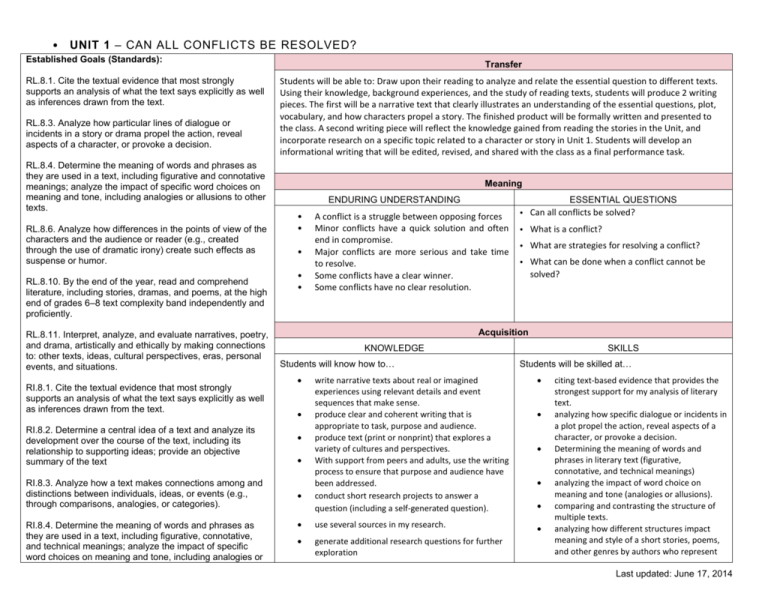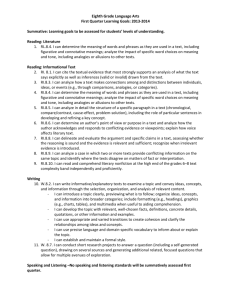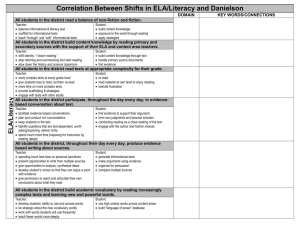8th ELA Unit 1 - Fairfield Township School
advertisement

• UNIT 1 – CAN ALL CONFLICTS BE RESOLVED? Established Goals (Standards): RL.8.1. Cite the textual evidence that most strongly supports an analysis of what the text says explicitly as well as inferences drawn from the text. RL.8.3. Analyze how particular lines of dialogue or incidents in a story or drama propel the action, reveal aspects of a character, or provoke a decision. RL.8.4. Determine the meaning of words and phrases as they are used in a text, including figurative and connotative meanings; analyze the impact of specific word choices on meaning and tone, including analogies or allusions to other texts. RL.8.6. Analyze how differences in the points of view of the characters and the audience or reader (e.g., created through the use of dramatic irony) create such effects as suspense or humor. RL.8.10. By the end of the year, read and comprehend literature, including stories, dramas, and poems, at the high end of grades 6–8 text complexity band independently and proficiently. RL.8.11. Interpret, analyze, and evaluate narratives, poetry, and drama, artistically and ethically by making connections to: other texts, ideas, cultural perspectives, eras, personal events, and situations. RI.8.1. Cite the textual evidence that most strongly supports an analysis of what the text says explicitly as well as inferences drawn from the text. RI.8.2. Determine a central idea of a text and analyze its development over the course of the text, including its relationship to supporting ideas; provide an objective summary of the text RI.8.3. Analyze how a text makes connections among and distinctions between individuals, ideas, or events (e.g., through comparisons, analogies, or categories). RI.8.4. Determine the meaning of words and phrases as they are used in a text, including figurative, connotative, and technical meanings; analyze the impact of specific word choices on meaning and tone, including analogies or Transfer Students will be able to: Draw upon their reading to analyze and relate the essential question to different texts. Using their knowledge, background experiences, and the study of reading texts, students will produce 2 writing pieces. The first will be a narrative text that clearly illustrates an understanding of the essential questions, plot, vocabulary, and how characters propel a story. The finished product will be formally written and presented to the class. A second writing piece will reflect the knowledge gained from reading the stories in the Unit, and incorporate research on a specific topic related to a character or story in Unit 1. Students will develop an informational writing that will be edited, revised, and shared with the class as a final performance task. Meaning ENDURING UNDERSTANDING • • • • • A conflict is a struggle between opposing forces Minor conflicts have a quick solution and often end in compromise. Major conflicts are more serious and take time to resolve. Some conflicts have a clear winner. Some conflicts have no clear resolution. ESSENTIAL QUESTIONS • Can all conflicts be solved? • What is a conflict? • What are strategies for resolving a conflict? • What can be done when a conflict cannot be solved? Acquisition KNOWLEDGE Students will know how to… SKILLS Students will be skilled at… write narrative texts about real or imagined experiences using relevant details and event sequences that make sense. produce clear and coherent writing that is appropriate to task, purpose and audience. produce text (print or nonprint) that explores a variety of cultures and perspectives. With support from peers and adults, use the writing process to ensure that purpose and audience have been addressed. conduct short research projects to answer a question (including a self-generated question). use several sources in my research. generate additional research questions for further exploration citing text-based evidence that provides the strongest support for my analysis of literary text. analyzing how specific dialogue or incidents in a plot propel the action, reveal aspects of a character, or provoke a decision. Determining the meaning of words and phrases in literary text (figurative, connotative, and technical meanings) analyzing the impact of word choice on meaning and tone (analogies or allusions). comparing and contrasting the structure of multiple texts. analyzing how different structures impact meaning and style of a short stories, poems, and other genres by authors who represent Last updated: June 17, 2014 Grade 8 ELA Unit allusions to other texts. RI.8.10. By the end of the year, read and comprehend literary nonfiction at the high end of the grades 6–8 text complexity band independently and proficiently. W.8.2. Write informative/explanatory texts to examine a topic and convey ideas, concepts, and information through the selection, organization, and analysis of relevant content. W.8.3. Write narratives to develop real or imagined experiences or events using effective technique, relevant descriptive details, and well-structured event sequences. W.8.4. Produce clear and coherent writing in which the development, organization, and style are appropriate to task, purpose, and audience. (Grade-specific expectations for writing types are defined in standards 1–3 above.) W.8.5. With some guidance and support from peers and adults, develop and strengthen writing as needed by planning, revising, editing, rewriting, or trying a new approach, focusing on how well purpose and audience have been addressed. W.8.6. Use technology, including the Internet, to produce and publish writing and present the relationships between information and ideas efficiently as well as to interact and collaborate with others. W.8.7. Conduct short research projects to answer a question (including a self-generated question), drawing on several sources and generating additional related, focused questions that allow for multiple avenues of exploration. W.8.9. Draw evidence from literary or informational texts to support analysis, reflection, and research. W.8.10. Write routinely over extended time frames (time for research, reflection, and revision) and shorter time frames (a single sitting or a day or two). L.8.4. Determine or clarify the meaning of unknown and multiple-meaning words or phrases based on grade 8 reading and content, choosing flexibly from a range of strategies. L.8.6. Acquire and use accurately grade-appropriate general academic and domain-specific words and phrases; use evidence from literary or informational texts to support analysis, reflection, and research. write stories, plays, and other works in response to what I have read in literature. effectively engage in discussions with diverse partners about eighth-grade topics, texts, and issues. express ideas clearly during discussions. build on others’ ideas during discussions use correct grammar and usage when writing or speaking use correct capitalization, punctuation, and spelling to send a clear message to my reader use a variety of strategies to determine the meaning of unknown words or phrases. analyze figurative language, word relationships, and nuances in word meanings. accurately use eighth-grade academic vocabulary to express my ideas use resources to build my vocabulary. diverse world cultures. interpreting, analyzing, and evaluating narratives, poetry, and drama, artistically and ethically by making connections to: other texts, ideas, cultural perspectives, eras, personal events, and situations. citing text-based evidence that provides the strongest support for an analysis of informational text. determining a theme or the central ideas of an informational text. analyzing the development of a theme or central idea throughout the text (including its relationship to supporting ideas). objectively summarizing informational text. Analyzing the connections and distinctions between individuals, ideas or events in a text. determining the meaning of words and phrases in text (figurative, connotative, and technical meanings). analyzing the impact of word choice on meaning and tone (analogies or allusions). Writing informative/explanatory texts that convey ideas and concepts using relevant information that is carefully selected and organized. Grade 8 ELA Unit gather vocabulary knowledge when considering a word or phrase important to comprehension or expression. Unit 1 Vocabulary Argument,compromise, injury,insecurity, interact, irate, mislead, negotiate, oppose, reaction, solution, stalemate, victorious, viewpoint, violence, prodigy, liable, reputation, pageant, periscope, gesture, cunningly, resolved, stealthily, vex, audacity, derision, Instruction and Pacing (suggested order to teach) Weeks 1-3 Begin Unit 1 in text Pearson Common Core Literature 8 Intro vocabulary/use in writing Character analysis of the main characters in stories Establish use of plot; making predictions; compare/contrast Read “Raymond’s Run”; “Tell-tale Heart” Establish historical background for text, author Analyze theme, inferences in each story Analyzing word choice, meaning, and tone Develop/prewriting for Narrative Story Language Study: Word roots, nouns, pronouns, adjective; adverbs, dictionary; thesaurus Discuss/respond to the Essential question as it applies to text Grade 8 ELA Unit 2 3 deceive, refute, intellectual, naivete, deterioration, introspective, persistent, inevitable, conviction, suppressed, immensely, assail, compulsory, meager, diplomatic, immortality, resolute, argument, argument, interact, negotiate, viewpoint, deficiciency, erosion, ravaged, interactions, reaction, viewpoint, region, aspects, elements Weeks 4-6 Continue Unit 1 in text Close reading and comparison of texts; “Tell-Tale Heart” and “Face in the Mirror” Open-ended response – comparison of texts Close reading of a complex informational text to expand understanding of Historical periods in text Vocabulary building Preparing to write a narrative essay by examining a model essay and the essay rubric Drafting, revising, and editing literary essay Introduction to the Final Performance task and initial research guidelines Language Study: Word roots, nouns, pronouns, adjective; adverbs, dictionary; thesaurus Discuss/respond to the Essential question as it applies to text Weeks 7-9 Read – Who Can Replace a Man? And “John Henry” Vocabulary, story comparison, respond to text Discuss/respond to the Essential question as it applies to text Complete and present final performance task Complete Unit 1 assessment, including comprehension, vocabulary, grammar and writing evaluation Grade 8 ELA Unit Common Misconceptions Students might think that the theme of the story is the same thing as the main idea of a story. Students might think they only need to know a word’s definition to successfully understand the word in a story. Proper Conceptions A theme is a lesson learned from a story, whereas the main idea is what a story is mostly about. Some words have multiple definitions and the context of the word is very important. Students may want to support their positions with only their own opinions. Students should be able to support their positions using the text. Students might choose text support that doesn’t relate to the topic. Students must choose text support and be able to explain how the details support their point. Students might summarize a text by choosing minor details. Students should summarize a text by addressing key points. Students may write narratives with incorrectly punctuated dialogue. Students must punctuate dialogue correctly with quotes. Students might write narratives which include too much dialogue that is confusing to follow. Students should use dialogue with purpose and to drive the plot. When engaging in discussion, students might feel it is OK to talk over each other or to interrupt the other person. Students must learn to listen respectfully to others opinions and to take turns during discussions. Students often write in an informal style, inappropriate to the audience. Students must be cognizant of their purpose for writing and address the audience with the correct formality as needed. When drafting writing, particularly if typing, students might be too cautious about correcting mistakes as they go. Students should understand that the writing process has several steps and that getting your rough ideas down does not require perfection. When publishing writing students often believe that they need to use colored, fancy, fonts, and pictures to supplement their ideas. Students in the middle grades should understand that their words can make their writing come to life and that a formal style is needed when publishing an essay or other formal writing piece. Grade 8 ELA Unit Resources Texts Pearson Common Core Literature 8 Prentice Hall Literature 8 Other • Students keep class notes in a folder. • Throughout this unit, students will keep a folder to collect and store all teacher-provided tote-catchers, text-dependent question handouts, and graphic organizers. • Teachers are encouraged to keep a model journal alongside students, in order to model note-taking and QuickWrites. • Unit Guiding Questions (one to display or post on chart or SmartBoard) • Student All-in-One Workbooks • Student Close Reading Guides • Word Wall Websites: Pearsonrealize.com Grade 8 ELA Unit Differentiation and Accommodations Accommodations: Teachers may differentiate research options for students depending on their experience with the research process. Teachers may scaffold the writing process in stages as needed for student success. Keep in mind that the students’ best independent draft of each essay will be used. Consider research texts for students that offer a range of Lexile measures and structures to offer a rich variety of texts with which students may engage. Students may share their stories with the class, display them in the school library, or publish them on the school’s Web site. Provide tutoring opportunities Provide retesting opportunities after remediation (up to teacher and district discretion) Teach for mastery not test Teaching concepts in different modalities Adjust pace and homework assignments Advanced options: Students will learn about situations that require an agreement between the conflicting parties. Students will write to give ideas and opinions as to how a problem is best solved and by doing so, develop narrative writing skills by paying close attention to details, word choice, organization, and conventions. Students may develop presentations about the historical aspects of the stories presented. These would be shared with the class, and may be done in small groups. Instructional Strategies Fairfield Township School recognizes the importance of the varying methodologies that may be successfully employed by teachers within the classroom and, as a result, identifies a wide variety of possible instructional strategies that may be used effectively to support student achievement. These may include, but not be limited to, strategies that fall into categories identified by the Framework for Teaching by Charlotte Danielson: Communicating with students Using questioning and discussion techniques Engaging students in learning Using assessment in instruction Demonstrating Flexibility and Responsiveness Grade 8 ELA Unit Interdisciplinary Connections • Social Studies, History and Geography • Science Connections-Science Fiction • Character Development-Social situations 21st Century Skills Critical thinking, problem solving, reasoning, analysis, interpretation, synthesizing information Research skills and practices, interrogative questioning Creativity, artistry, curiosity, imagination, innovation, personal expression Perseverance, self-direction, planning, self-discipline, adaptability, initiative Oral and written communication, public speaking and presenting, listening Leadership, teamwork, collaboration, cooperation, virtual workspaces Information and communication technology (ITC) literacy, media and internet literacy, visual interpretation, data interpretation and analysis, computer programming Civic, ethical, and social-justice literacy Economic and financial literacy, entrepreneurialism Global awareness, multicultural literacy, humanitarianism Scientific literacy and reasoning, the scientific method Environmental and conservation literacy, ecosystems understanding Health and wellness literacy, including nutrition, diet, exercise, and public health and safety Performance Task A second writing piece will reflect the knowledge gained from reading the stories in the Unit, and incorporate research on a specific topic related to a character or story in Unit 1. Students will develop an informational writing that will be edited, revised, and shared with the class as a final performance task. Grade 8 ELA Unit ASSESSMENTS Section 1: Assessment quiz following each story PEARSON Common Core Literature 8 End of Unit: Assessment quiz – Open-ended writing task reflecting on the stories in Section 1. (Literature 8, Writing to sources) Section 2: Assessment quiz following each story PEARSON Common Core Literature 8 End of Unit: Assessment quiz – Open-ended writing task reflecting on the stories in Section 1. (Literature 8, Writing to sources) Section 2: Assessment quiz following each story PEARSON Common Core Literature 8 End of Unit: Assessment quiz – Open-ended writing task reflecting on the stories in Section 1. (Literature 8, Writing to sources) Pearsonrealize.com online assessment End of Unit Baseline Pretest- Beginning of the year Post test – End of the year Completed Final performance task








